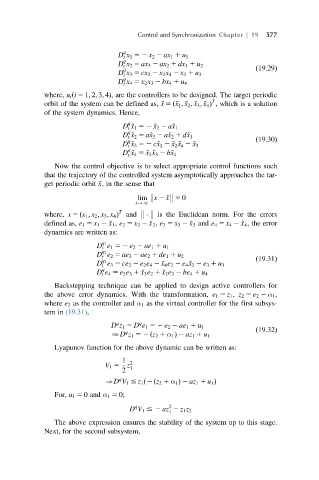Page 607 - Mathematical Techniques of Fractional Order Systems
P. 607
Control and Synchronization Chapter | 19 577
q
D t x 1 52 x 2 2 ax 1 1 u 1
q
D t x 2 5 ax 3 2 ax 2 1 dx 1 1 u 2
q ð19:29Þ
D t x 3 5 cx 2 2 x 2 x 4 2 x 3 1 u 3
q
D t x 4 5 x 2 x 3 2 bx 4 1 u 4
where, u i ði 5 1; 2; 3; 4Þ, are the controllers to be designed. The target periodic
T
orbit of the system can be defined as, ~ x 5 ð~ x 1 ; ~ x 2 ; ~ x 3 ; ~ x 4 Þ , which is a solution
of the system dynamics. Hence,
q
D t ~ x 1 52 ~ x 2 2 a~ x 1
q
D t ~ x 2 5 a~ x 3 2 a~ x 2 1 d~ x 1
q ð19:30Þ
D t ~ x 3 52 c~ x 2 2 ~ x 2 ~ x 4 2 ~ x 3
q
D t ~ x 4 5 ~ x 2 ~ x 3 2 b~ x 4
Now the control objective is to select appropriate control functions such
that the trajectory of the controlled system asymptotically approaches the tar-
get periodic orbit ~ x, in the sense that
lim :x 2 ~ x: 5 0
t-N
T
where, x 5 ðx 1 ; x 2 ; x 3 ; x 4 Þ and : : is the Euclidean norm. For the errors
defined as, e 1 5 x 1 2 ~ x 1 , e 2 5 x 2 2 ~ x 2 , e 3 5 x 3 2 ~ x 3 and e 4 5 x 4 2 ~ x 4 , the error
dynamics are written as:
q 1
D t e 1 52 e 2 2 ae 1 1 u 1
q 2
D t e 2 5 ae 3 2 ae 2 1 de 1 1 u 2
ð19:31Þ
q 3
D t e 3 5 ce 2 2 e 2 e 4 2 ~ x 4 e 2 2 e 4 ~ x 2 2 e 3 1 u 3
q
D t e 4 5 e 2 e 3 1 ~ x 3 e 2 1 ~ x 2 e 3 2 be 4 1 u 4
Backstepping technique can be applied to design active controllers for
the above error dynamics. With the transformation, e 1 5 z 1 , z 2 5 e 2 2 α 1 ,
where e 2 as the controller and α 1 as the virtual controller for the first subsys-
tem in (19.31),
q q
D z 1 5 D e 1 52 e 2 2 ae 1 1 u 1
q ð19:32Þ
ð
.D z 1 52 z 2 1 α 1 Þ 2 az 1 1 u 1
Lyapunov function for the above dynamic can be written as:
1
V 1 5 z 2 1
2
q
.D V 1 # z 1 ð2 ðz 2 1 α 1 Þ 2 az 1 1 u 1 Þ
For, u 1 5 0 and α 1 5 0;
q 2
D V 1 #2 az 2 z 1 z 2
1
The above expression ensures the stability of the system up to this stage.
Next, for the second subsystem,

